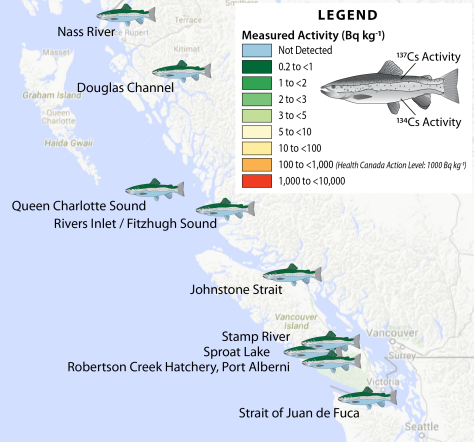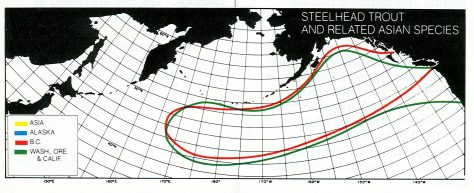
The measurements undertaken as part of the InFORM project to look for Fukushima derived radionculides in fish during our first of three years of monitoring are now complete. Sockeye salmon (Oncorhynchus nerka) and Steelhead Trout (Oncorhynchus mykiss) (as well as some Chinook, Chum and Pink Salmon) were caught off the west coast of Canada in Summer 2014 as they were returning to 9 different streams and rivers up and down the coast of British Columbia Canada. These results add to the first 19 fish which we reported on in December of 2014.
What we have found so far:
- None of the fish from 2014 were found to contain detectable levels of 134Cs. What this means is that radioactivity from Fukushima cannot be detected in fish caught in BC waters as of August 2014
- Nuclear weapons testing fallout (137Cs) can be detected in BC fish at levels that represent a fraction of Health Canada guidelines (1000 Bq kg-1) and a fraction of the radiation exposure owing to naturally occurring radionuclides
- Neither the 137Cs nor the naturally occurring radioisotopes in fish represent a measureable health risk to consumers in Canada
What are we measuring and why?
The triple meltdowns at the Fukushima Dai-ichi nuclear power plant (NPP) released many different radioisotopes to the environment, however only a very few of these are both measurable and unique to Fukushima. A reliable finger-print radioisotope for Fukushima is Cesium-134 (134Cs half life ~ 2 years). This is because 134Cs is only produced in nuclear reactors and it has a relatively short half-life, so that 134Cs from other human sources, like the Chernobyl NPP disaster in 1986, are no longer present in the environment. Other isotopes such as Cesium-137 (137Cs half life ~30 years) are not positive indicators of Fukushima since they were also a products of atmospheric testing in the 20th century and Chernobyl and are still present in the environment from these legacy sources.
How scientists talk about radioactivity in the environment
Scientists use a variety of units to measure radioactivity. A commonly used unit is the Becquerel (Bq for short) which represents an amount of radioactive material where one atom decays per second and has units of inverse time (per second). Another unit commonly used is disintegrations per minute (dpm) where the number of atoms undergoing radioactive decay in one minute are counted (so 1 Bq = 60 dpm). The measurements above represent that numbers of Bq detected in a kilogram of fish flesh.
Measurements of Sockeye Salmon and Steelhead Trout
We measured the activities of cesium radioisotopes 134Cs and 137Cs that were released in large quantities from the Fukushima Dai-ichi Nuclear Power Plant disaster in 2011. We also measured naturally occurring radioisotopes Potassium-40 (40K) and Polonium-210 (210Po) that always contribute doses of radiation to human consumers of marine fish. Samples (99 total) of sockeye salmon and steelhead returning BC streams and rivers were collected and analyzed and none were found to contain detectable levels of Fukushima derived radionuclides. By adding together the signals obtained for all the fish collected from a given sampling location we can calculate and detect an average activity concentration of 137Cs. This represents residual 137Cs in the North Pacific largely from atmospheric nuclear weapons testing in the last century. At present, Fukushima derived radionuclides cannot be detected in any of the fish we have collected as of 2014. Nuclear weapons testing fallout (137Cs) can be detected in BC fish at levels that represent a fraction of the radiation exposure owing to naturally occurring radionuclides. Neither the exposure to artificial or natural radionuclides represent a dangerous health risk to consumers in Canada. We plan to collect more sockeye, steelhead and pink salmon this year to continue to monitor for Fukushima contamination and report results as they are generated here.
Measurements of radioactive elements in these fish are reported in the data table below and are available for download through Health Canada.
MDC stands for Minimum Detectable Concentration.
The Importance of Salmon to Canadians
Pacific salmon are economically, culturally, and ecological significant species to British Columbia. On an annual basis, the commercial, recreational, and First Nation salmon fisheries contribute over $600 million in revenues. They are an important food source to First Nations and coastal communities, and numerous animal species such as endangered Killer Whales, Gray Wolf, Grizzly Bear, seabirds, and insects. They provide nutrients to freshwater ecosystems and riparian habitats through the decomposition of their carcass.
There are six species of Pacific salmon in British Columbia. During the first year of the project, InFORM will focus primarily on Sockeye Salmon (Oncorhynchus nerka) and Steelhead Trout (Oncorhynchus mykiss), though other salmon species have and will be examined. Both species typically spend 2-3 years in the North Pacific Ocean prior to returning to their natal streams and venture further west than any other salmon species (Figure 1-2). On an annual basis, 1-10 million Sockeye Salmon are commercially harvested for human consumption and ceremonial purposes. In contrast, the fishery for Steelhead Trout is primarily catch and release due to conservation concerns for this species, particularly in Southern British Columbia. Although wild Steelhead Trout are not frequently consumed in Canada, their extensive westward migration that brings them close to the coast of Japan makes them an ideal canary species for monitoring radiation levels in salmon species originating from British Columbia.

Figure 2. Approximate range for the distribution of Steelhead Trout in the North Pacific Ocean originating from British Columbia (red) and Washington, Oregon, and California (green). Source: http://www.pac.dfo-mpo.gc.ca/fm-gp/species-especes/salmon-saumon/facts-infos/steel-arc-eng.html
Technical Information Regarding Sample Analyses
- 99 fish samples, flesh only were obtained through the cooperation of Fisheries and Oceans Canada and the Nisga’a First Nation
- A sub-sample of ~125 g of wet mass was taken and placed in a sample counting container
- Gamma-radiation emitting isotopes were measured by gamma spectroscopy using a high purity germanium detector and each sample being counted for 6 hours
- Planar BE5030 high purity germanium (HPGe) detector with relative counting efficiency of 46%
- counting geometry = Parkway Jar (Polyethylene, active volume = 129 mL) placed in a polyacrylate sample holder (2.95 mm thickness)
- counting efficiency was determined by applying an empirical efficiency curve, determined from a multi-nuclide (12) standard (Eckert and Ziegler Analytics, SRS: 79535-411) of similar density (1.15 g/cm^3, Parkway Jar format) spanning energies of 46.5 – 1836.1 KeV
- true coincidence summing (where applicable) is accomplished by extracting detailed decay scheme data from the UniSampo-Shaman nuclide library
- Spectral summation was done by adding all the spectrum into a single one and then reanalysed using UniSampo-Shaman gamma spectral analysis software from Baryon Oy, Ltd., Finland, with decay correction to the catch date


Reblogged this on Liberty Host Page.
LikeLike
If I put the information in Figure 1 together with the image of the “blob” you posted today, I’d conclude that BC sockeye would likely be exposed to those warm waters in the blob–and that Alaskan sockeye would not. But, hey, I’m not a scientist, and I’m sure I could be missing pertinent facts.
What are your thoughts on that conclusion?
And where is the green line in Figure 1 to show the migration of Washington and Oregon salmon? Would you mind fixing the image?
LikeLike
Hi Harriet. The warm temperature anomaly covers most of the Gulf of Alaska and northeast Pacific (http://www.oceannetworks.ca/warm-northeast-pacific-ocean-conditions-continue-2015). Both populations likely have spent time foraging in warmer than usual water. Will look for figure but Ore/Wash populations also spend time in Gulf of Alaska. To be clear the lines aren’t migration route but range of the populations.
LikeLike
Did you ever publish the article we discussed some time ago?
LikeLike
My editor wanted to wait until the fall. That’s why I’ve been silent until now.
Thanks for this. I mistakenly assumed migration route.
LikeLike